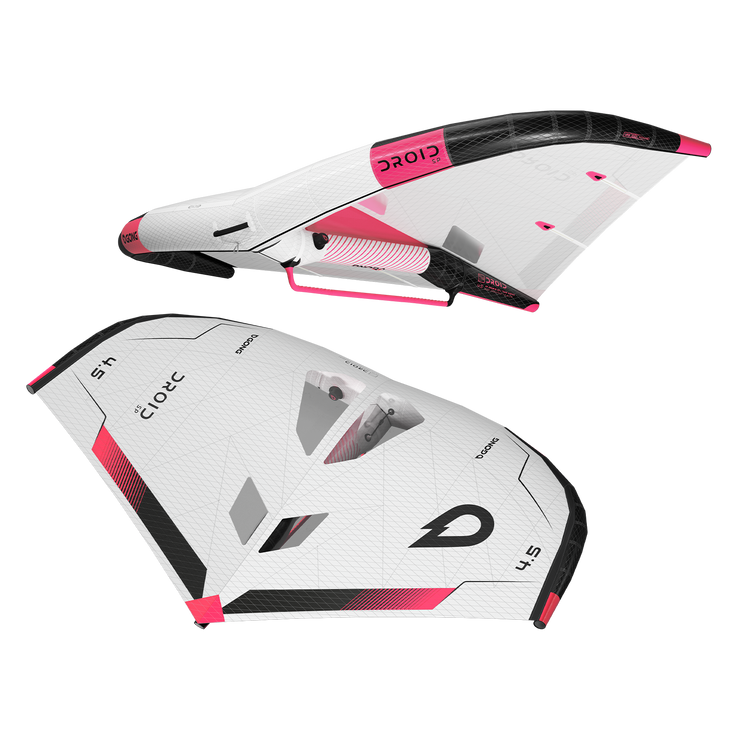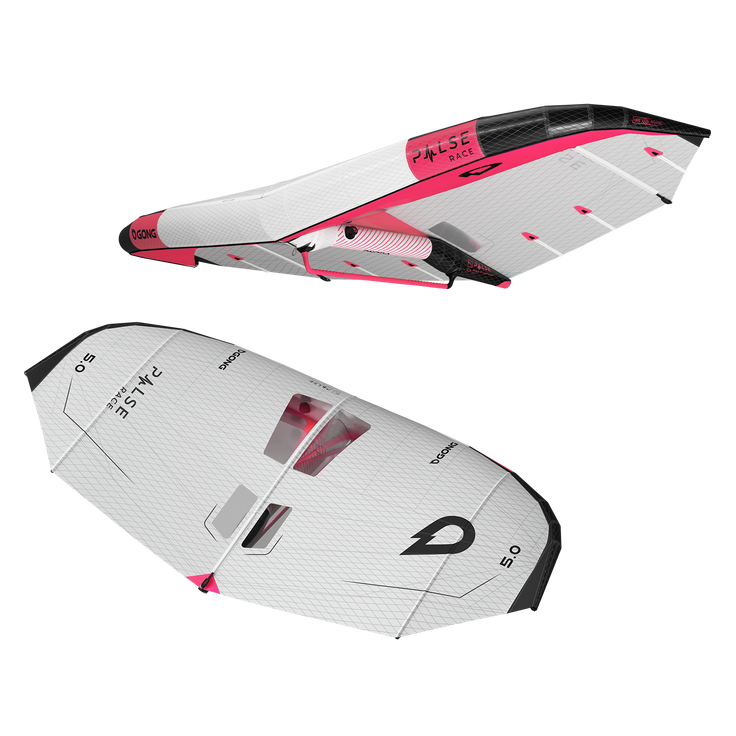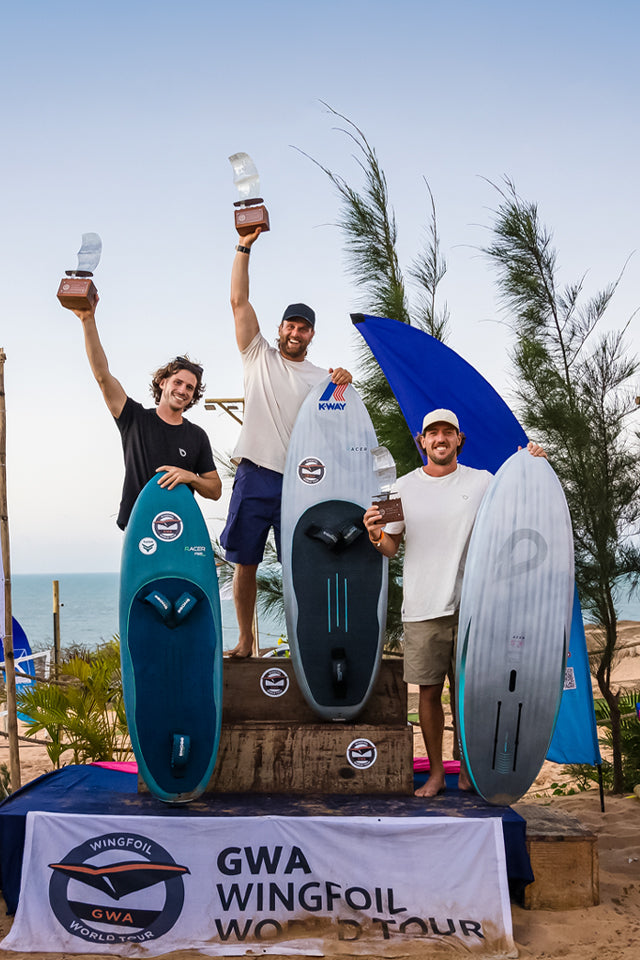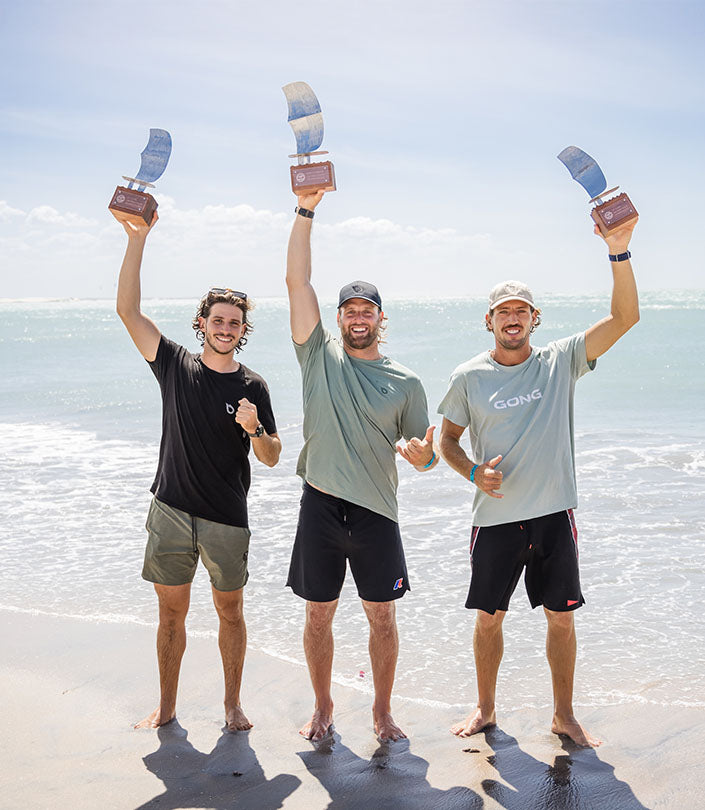Wing Droid SP Aramid CZ
Wing Pulse Race Aramid CZ
Introduction: wings designed for racing
Racing in wingfoil is the pinnacle of the "speed" aspect in wingfoiling, requiring precision and top-level performance.
Whether it's navigating long, technical race courses, executing explosive slalom runs, or challenging friends in freerace, this discipline demands cutting-edge equipment optimized to push the limits.
At GONG, we have designed a complete range of wings perfectly suited to these needs, offering power, control, and maneuverability. The Pulse and Droid, available in several technologies (Perf, Team, Team Pro), represent the best of racing.
Their innovative design and performance allow you to dominate the courses, whether you're a beginner, expert, or professional.
The genesis of GONG wings for racing
Since 1996, GONG has been innovating to meet the needs of glide sports enthusiasts. With the rise of racing in wingfoil, we have focused our expertise on wings capable of generating maximum speed, effectively upwind, quickly downwind, and offering total control at high speeds.
Racing imposes unique technical constraints: wings must be rigid to optimize power, remain maneuverable for precise buoy turns, and stable to maximize speed while maintaining control.
Our models, such as the Pulse and Droid, embody this perfect balance and adapt to all levels of practice.
The qualities of GONG wings for racing
World Champion in Long Distance Racing, the Pulse is a reference that revolutionized the credibility of wings in racing thanks to the invention of the double airfoil by Patrice Guénolé.
World Champion in Slalom, and occupying all three spots on the World Championship podium, the Droid is THE benchmark for high performance.
- Innovation: The invention of the double airfoil by GONG is a pivotal moment in the history of wing racing, but the introduction of new materials such as UPE Aramid is just as crucial.
- Speed: Wings capable of generating optimal apparent wind and maintaining maximum glide.
- Power: An efficient power base for quick starts, boosting, and optimal upwind performance.
- Control: Unshakable stability at high speeds, essential for dominating the courses and maintaining mental strength.
- Maneuverability: Responsive designs for executing tight jibes, especially in slalom.
- Durability: A robust construction that withstands the intense demands of racing sessions.
- Versatility in Performance: Wings adapted to racing, slalom, and intense freerace.
Detailed comparisons and tips for racing
Each GONG wing in the racing range is designed to maximize your performance on the courses, with specific features tailored to your skill level and ambitions. Here’s a comparison of the advantages of each model, categorized by range.
Perf Range (Dacron Technology)
Accessible and versatile wings, perfect for discovering the racing discipline.
Droid Perf:
- Advantages: Compact and responsive, it offers optimal maneuverability for precise buoy turns.
- For whom? Slalom enthusiasts looking for a high-performing yet accessible wing.
- Why is it ideal? Its balanced shape and compact design allow excellent control during quick transitions.
Pulse Perf:
- Advantages: Powerful and fast with its 30% double airfoil, it excels in long upwind legs and full-speed downwind runs.
- For whom? Amateur riders seeking a stable and efficient wing for race courses.
- Why is it ideal? Its consistent power base ensures maximum performance in all conditions.
Team Range (UPE Aramid Technology)
Ultra-light and dynamic wings designed for regular and expert riders looking for enhanced performance.
Droid Team:
- Advantages: Compact and rigid, it is ideal for fast and demanding slaloms.
- For whom? Expert riders seeking a lively and precise wing for technical courses requiring reactivity and rapid acceleration.
- Why is it ideal? Its UPE Aramid construction delivers exceptional lightness and rigidity, essential for maximizing responsiveness.
Pulse Team:
- Advantages: Ultra-high performance with its broad double airfoil, it combines glide and power to dominate race courses.
- For whom? Expert and professional riders aiming to maximize their speed and glide.
- Why is it ideal? Its stability in a fleet and its ability to generate powerful apparent wind ensure unmatched performance in races.
Team Pro Range (Aramid X Technology)
Premium wings for professional riders, designed for maximum performance in racing.
Droid Team Pro:
- Advantages: Extreme rigidity, power, and maneuverability for precise and explosive slaloms.
- For whom? Professional riders seeking the ultimate wing to excel in slalom courses.
- Why is it ideal? Its advanced construction ensures perfect control and quick transitions, even at full power and top speed.
Focus on GONG wing technology for racing
Racing demands wings that combine power, rigidity, and glide while offering total control at high speeds. Whether it's for efficient upwind runs, precise buoy turns, or full-speed downwind sprints, GONG racing wings meet the expectations of the most demanding riders.
Common Features Across All Three Technologies
- Reinforced Canopy: Our fabrics are reinforced to ensure optimal tension, essential for maximizing power and stability at high speeds.
- Reinforced Seams: Tested to withstand the intense and repeated stresses of racing sessions.
- Boom/Handle Attachment Reinforcements: Robust yet lightweight systems ensure perfect balance and optimal responsiveness.
- Multiple Reinforcements: Materials like Kevlar, Insignia, and Dacron provide enhanced durability, even after intense sessions.
- Specialized Panel Layout: Designs minimize stretching and twisting, maximizing glide and stability.Durable Bladders: Engineered to maintain constant pressure and resist frequent handling.
- Meticulous Construction: Every detail is designed to maximize longevity and minimize wear, even with repeated high-power sessions.
Dacron - Perf Range
An accessible and versatile option, ideal for progressing in racing.
- Dacron Structure: This material ensures excellent tolerance and balanced power, making it perfect for learning technical courses.
- Triple Ripstop Canopy: A lightweight, durable fabric offering comfort and longevity.
- Applications: Wings in this range, such as the Droid Perf and Pulse Perf, are perfect for amateur riders exploring the world of racing.
Aramid - Team Range
Lightweight and dynamic wings designed for regular riders seeking enhanced performance.
- Aramid Structure: With a record-breaking weight of 85 g/m², this material delivers a lively, rigid, and responsive wing.
- Triple Ripstop Canopy: Durable yet lightweight construction ensures ideal precision at high speeds.
- Applications: Wings like the Droid Team and Pulse Team cater to expert riders aiming for optimal performance in racing and slalom.
Aramid X - Team Pro Range
The pinnacle of GONG technology, tailored for professional riders seeking maximum performance.
- Aramid Structure: Provides optimal rigidity and dimensional stability under pressure, essential for high-level racing.
- Code 95 X Canopy: A highly rigid fabric that delivers instant responsiveness and maximum durability in form and resistance.
- Applications: The Droid Team Pro is perfect for professional riders seeking a fast, precise, and maneuverable wing for slalom.
Summary of Advantages by Range
- Perf Series (Droid Perf, Pulse Perf): Ideal for amateur riders thanks to their tolerance, maneuverability, and balanced power base.
- Team Series (Droid Team, Pulse Team): Perfect for regular riders looking for lightweight, robust, and enhanced performance wings.
- Team Pro Series (Droid Team Pro): Excellence for professional riders, offering unmatched rigidity, maneuverability, and top-tier racing performance.
Testimonials from racing riders
Droid Perf:
- “It turns like a dream in fast slaloms.”
- “Perfect for starting out in racing with control and confidence.”
Pulse Team:
- “A fast and stable wing, ideal for efficient upwind runs.”
- “Its performance is incredible on downwind legs.”
Droid Team Pro:
- “The best wing for pro slalom. Unmatched rigidity and maneuverability.”
FAQ: Frequently asked questions about racing
Q: Which wing is best suited for a beginner in racing?
A: The Droid Perf is ideal for starting out in slalom due to its maneuverability and tolerance. The Pulse Perf is better suited for those who want to try racing with a high-performing yet accessible wing.
Q: Is the Droid Team suitable for freerace?
A: Absolutely. Its compactness and responsiveness make it a perfect choice for intense sessions that combine speed and maneuverability on varied courses.
Q: What’s the difference between the Pulse and the Droid?
A: The Droid is compact and ultra-maneuverable, perfect for slalom where tight turns are frequent. The Pulse, on the other hand, is more race-oriented with consistent power and excellent glide for long courses.
Q: Can a racing wing be used for freeride?
A: Yes, these wings provide a sporty and engaging freeride experience, especially for riders seeking more speed and technical sensations.
Q: Is the Droid Team Pro suitable for an intermediate rider?
A: No, the Droid Team Pro is designed for expert or professional riders. Its rigidity and performance require a high level of technical skill.
Q: What is the ideal wing size for racing?
A: For racing, sizes between 5m² and 6.5m² are generally preferred, offering the right balance of power, maneuverability, and control depending on wind conditions and your weight.
Q: Can I compete in a slalom competition with a Perf wing?
A: Yes, Perf wings like the Droid Perf and Pulse Perf allow participation in amateur competitions. However, the Team or Team Pro models will provide a significant performance advantage.
Conclusion: the ideal wings for racing
GONG racing wings, such as the Droid and Pulse, represent the perfect balance of speed, maneuverability, and control.
Whether you're an amateur or an expert, each model is designed to maximize your performance and push your limits on the water.
Experience racing wingfoil with GONG and reach new heights of speed and precision!
Shapes, dimensions and program
Understanding the Elements That Influence Your Wing's Performance and Feel
Understanding the factors that influence your wing's performance and feel is essential to choosing the perfect model.
Here are the key parameters to refine your choice:
Technical Parameters That Influence Performance
1. Camber
Camber determines the type of power generated by the wing.
- A pronounced camber provides more power for early takeoff, ideal in light wind conditions or for beginner riders seeking traction.
- A reduced camber prioritizes speed and stability in the high wind range, perfect for competitions or sessions in strong wind.
- A forward camber facilitates takeoff and generates more direct traction, offering a constant sense of control. It is ideal for marginal conditions or for riders seeking maximum lift.
- A recessed camber promotes smoother glide, making it particularly suitable for disciplines where finesse and speed are key, such as racing or wave riding.
2. Dihedral Angle
The dihedral corresponds to the angle formed by the two halves of the wing when viewed flat from the front.
- A pronounced dihedral makes flips easier, reduces power, simplifies tension and the appearance of the wing, and keeps the tips away from the water.
- A reduced dihedral improves aerodynamic efficiency, maneuverability, precision, and power but requires more precise work on tension.
3. Span
The span influences stability and maneuverability.
- A large span stabilizes and smooths the flight and optimizes glide.
- A reduced span increases power, enhances rotation and agility, and is ideal for freestyle or wave riding.
4. Aspect Ratio
The aspect ratio (span divided by width) directly impacts the wing’s behavior.
- A high aspect ratio promotes glide, speed, and directional stability.
- A low aspect ratio makes the wing more maneuverable, torque-rich, and accessible, making it perfect for beginners or freestyle.
5. Canopy Tension
The tension applied to the canopy directly impacts the stability and feel of the wing.
- High tension maintains the wing’s shape at its maximum efficiency, offering precise handling and increased stability, even in gusts. It is ideal for technical riders seeking maximum performance and consistent behavior.
- Soft tension allows the wing to "breathe" and adapt to wind variations, relieving the rider during long sessions or in irregular conditions. This is perfect for more comfortable freeriding but may lead to flapping and instability. A wing that self-regulates is good; a wing that deforms uncontrollably is not.
6. Leading Edge Curve
The curve affects rigidity and force distribution.
- A pronounced curve generates more power and improves low-end stability.
- A flatter curve increases maximum speed and responsiveness.
7. Trailing Edge Curve
- Positive curve (curved backward): Promotes power and efficiency during pumping but risks excessive flapping.
- Negative curve (curved forward): Reduces drag and flapping, ensuring maximum performance when properly powered.
8. Tip Shape
- Wide tips improve stability during takeoff and simplify control.
- Narrow tips reduce drag and enhance maneuverability but require more technical skill.
9. Tip Twist
The twist influences the distribution of power.
- Pronounced twist provides better control in gusty winds.
- Reduced twist maximizes power but can become difficult to handle in high wind ranges.
10. Panel Cut Design
The cut of the panels influences canopy tension and load distribution.
- Well-adjusted panels ensure shape stability and a more durable performance level.
- Multiple panels allow easier masking of potential repairs.
- However, more panels increase weight and cost due to longer stitching lengths.
11. Leading Edge Diameter
- A wide leading edge in the center improves structural rigidity and resistance to flex, increasing power but adding weight and drag.
- A thinner leading edge in the center allows for more flex, requiring higher inflation pressure. It results in a more refined profile.
- At the tips, a thinner diameter reduces drag and enhances maneuverability.
12. Central Strut Connection to Leading Edge
- A strong central strut connection to the leading edge limits tip twist, increasing responsiveness and power transfer to the rider. It also prevents trailing edge flapping.
- A weaker connection allows more twist, increasing tolerance and self-regulation, but it must be well-controlled.
13. Central Strut Shape
- A rigid central strut increases responsiveness and power transfer to the rider.
- A softer strut offers greater tolerance in changing conditions, allowing the trailing edge to open. However, this can lead to flapping and variations in the center of the power point.
14. Presence of Additional Battens
- Some wings incorporate side battens to increase rigidity and improve control.
- This increases weight and reduces maneuverability.
15. Anti-Vibration Battens on the Trailing Edge
- These specific battens reduce flutter and ensure silent and stable glide, improving durability.
Adapt Your Wing to Your Style and Needs
The above characteristics must be considered based on your program (racing, freestyle, wave riding, etc.) and the conditions in which you ride.
- A freestyle rider will favor a compact and responsive wing.
- A free-fly enthusiast will look for a stable and lightweight wing.
These elements shape the essence of each model, directly influencing its performance and feel on the water. You now have the tools to choose the wing that perfectly matches your ambitions.
DACRON Wing Technology
DACRON Wing technology
Our wings are made in one of the two largest kite and wing factories in the world according to the quality standards of the best wings.
They are built with the greatest care. The panels are CNC cut and entirely assembled by hand by the best workers in the kite industry.
The materials we use for our wings are among the finest. We are looking for performance of course but we also want endurance and therefore materials that have proven themselves:
- Leading edge and central strut in very rigid and durable Dacron DP175LL.
- Top of the range triple Ripstop spinnaker for anti propagation of tears in 54g/m2.
- Insigna reinforcements on all seams for greater durability.
- Tip saver in 1680D Nylon to protect against friction on the tips.
- Kevlar reinforcements under the handle/boom attachments on the central strut.
- 80 micron thick TPU cushions.
- One Pump system for quickly inflating and deflating.
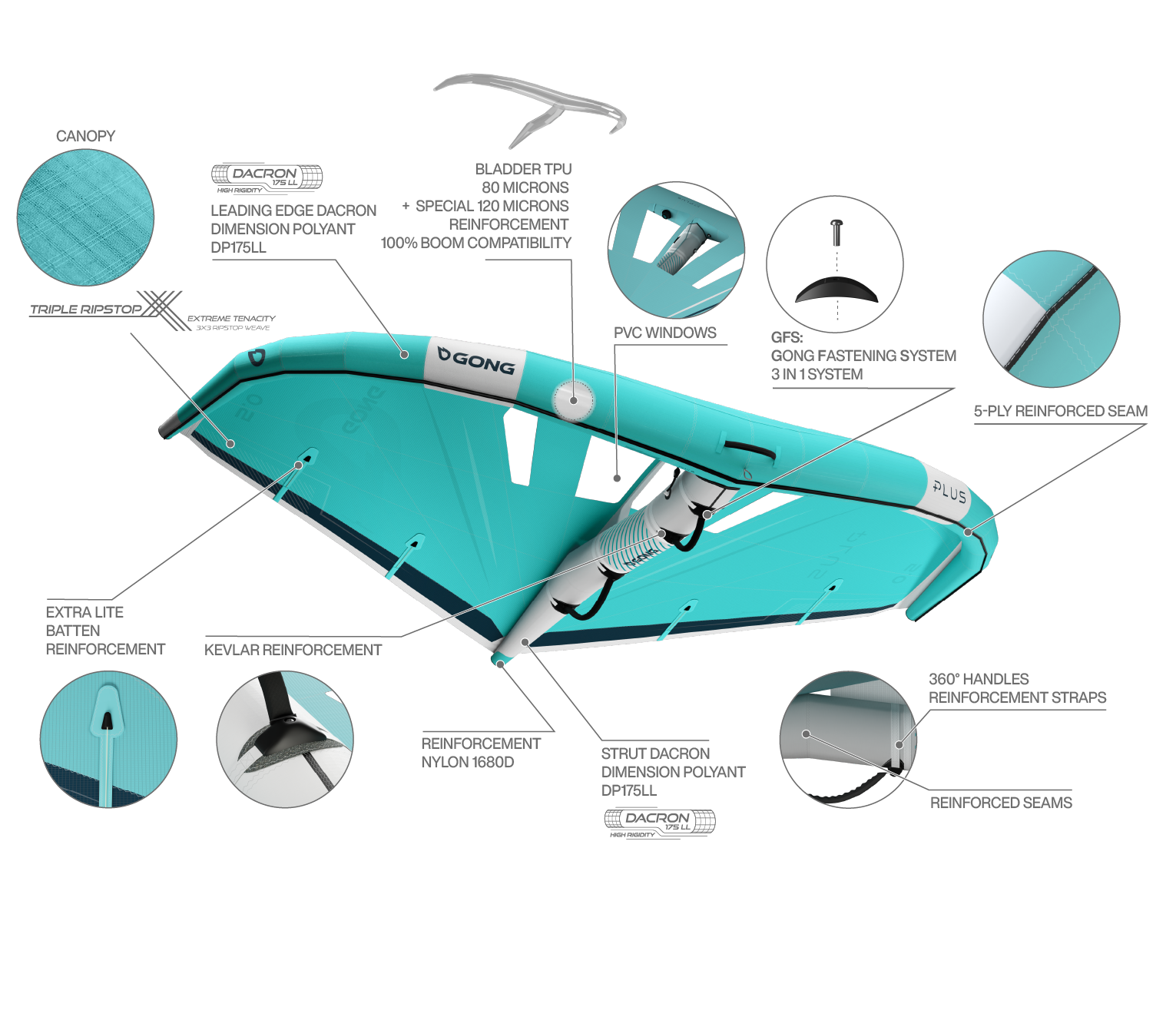
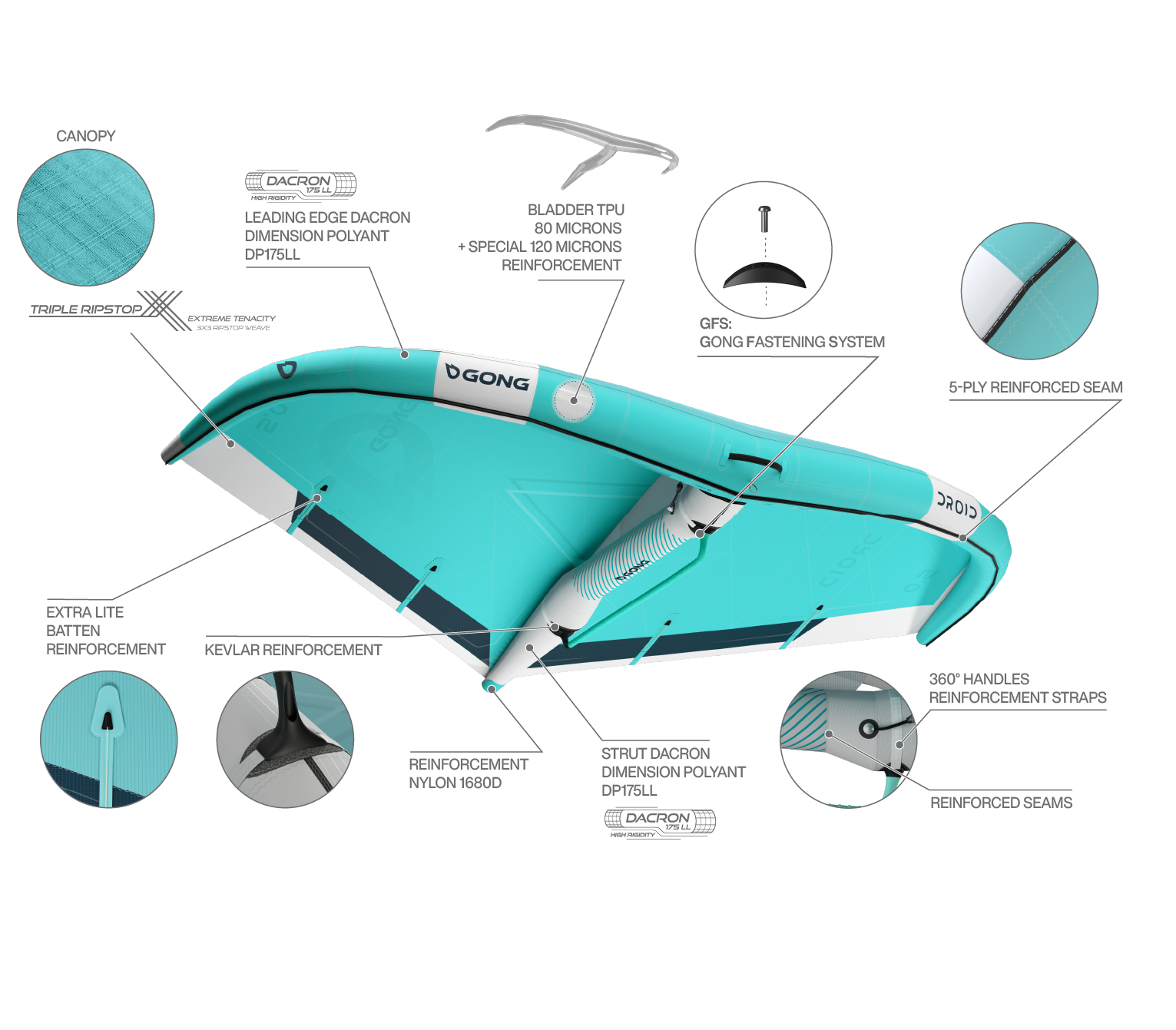
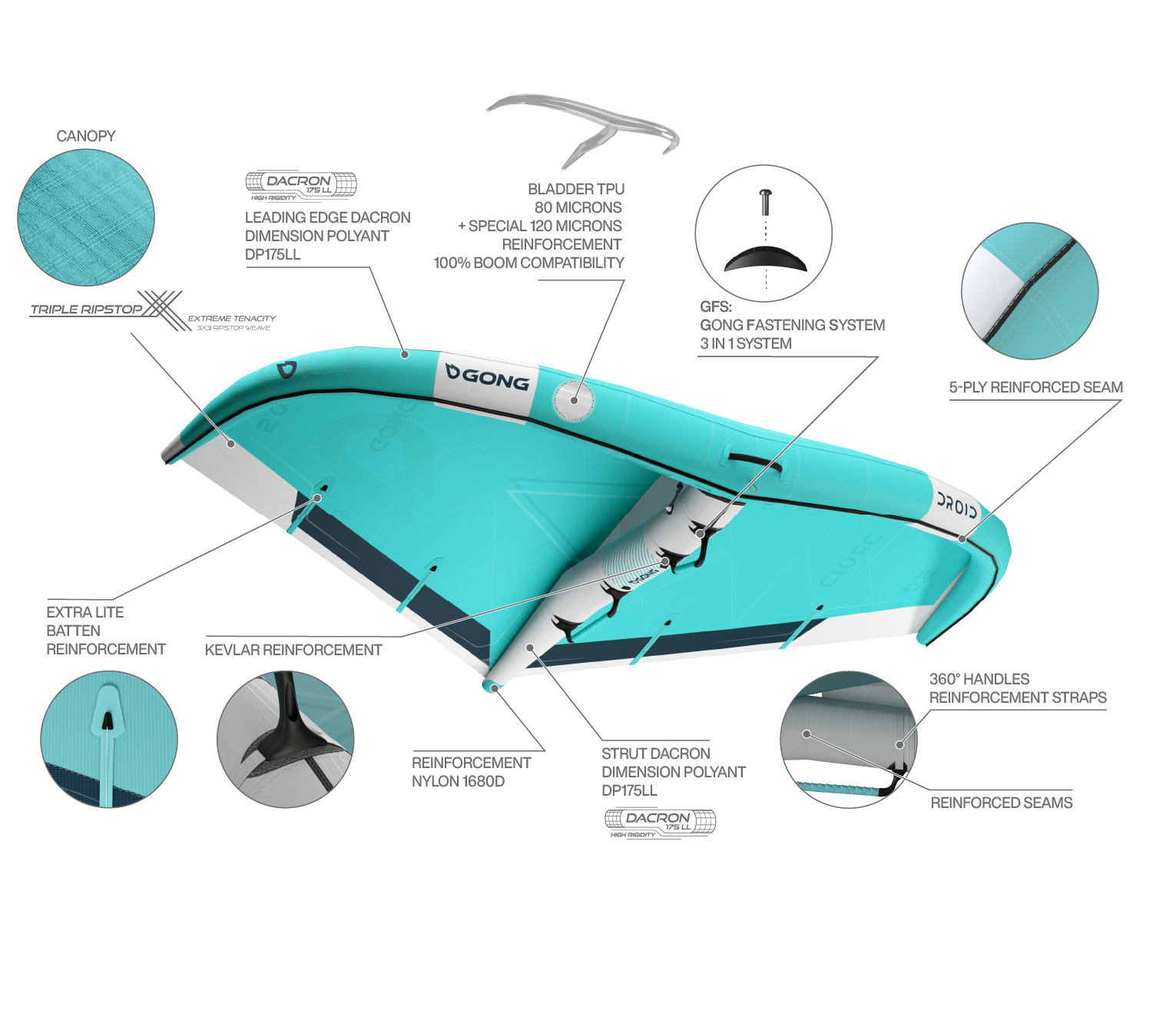
UPE ARAMID technology
UPE ARAMID technology
The Droïd UPE Aramid benefits from the most advanced technology to excel in freestyle:
The UPE Aramid, a true gem of textile technology developed by experts in nautical textiles.
How does it work?
- The PET film ensures the connection between the elements and waterproofing.
- The Aramid fibers are arranged at a chosen angle to block the fabric’s extension under load without unnecessarily adding weight to the structure.
- The thin layer of UPE, lighter than on UPE 200, ensures strength. This tight weave of Dyneema fibers is a veritable shield.
These three laminated layers create a fabric that is both extremely lightweight, highly rigid, and very resistant to tearing.
Our exclusive assembly, tested in the laboratory and by the Pro Team, ensures unparalleled longevity for UPE Aramid.
The whole system is so rigid that 8 PSI gives you the rigidity of a UPE 200 at 15 PSI. It’s truly deformation-resistant.
Less pressure = less stress in the wing = less time spent pumping.
More durability, performance, and lightness: the holy grail.
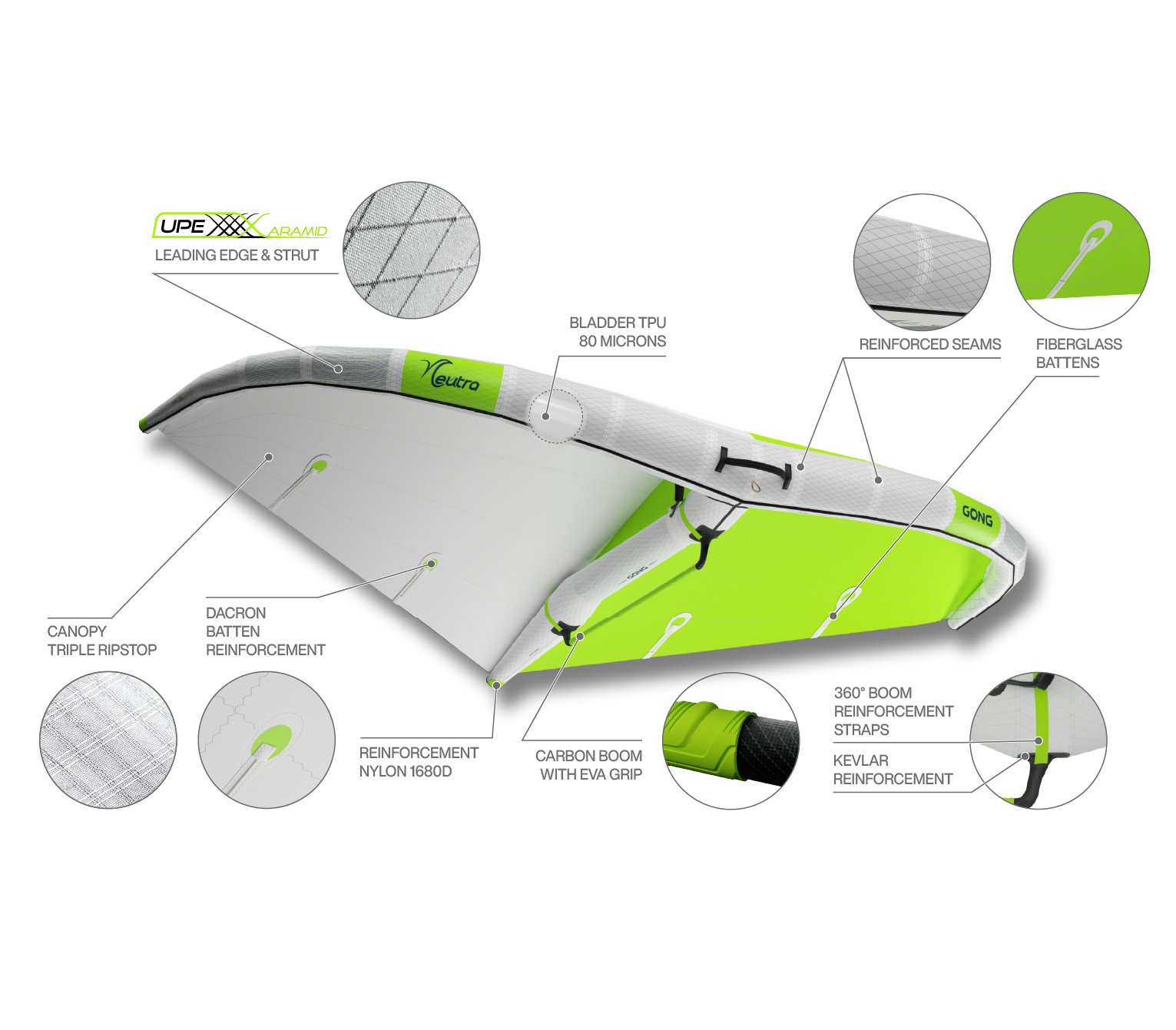
Good to know
Tips and Advice to Optimize Your Wing Usage
Here are the essential points and best practices to maximize your performance in wingfoil and extend the lifespan of your equipment:
1. Adjust Inflation and Pressure
- Strictly follow the recommended pressure guidelines to optimize the wing's rigidity.
- Underinflation leads to performance loss, less precise shape, and can cause flapping.
- Always inflate to the maximum recommended pressure using an appropriate pump (dual action for initial inflation, single action for finalizing).
2. Proper Wing Maintenance
- Rinsing: Avoid systematically rinsing with fresh water, as salt can help prevent mold. If you rinse, do so sparingly to avoid damage from chlorine.
- Drying: Prefer drying the wing flat or inflated to prevent bladder displacement. Never hang a deflated wing by a handle.
- Storage: Store your wing away from sunlight, humidity, and extreme temperatures. Excessive heat or cold can degrade the materials.
3. Handling and Precautions
- On the beach: Place your wing on a clean surface, away from sharp or puncturing objects.
- While riding: Keep the wing out of the water as much as possible, especially in waves. A fall in waves can severely damage the fabric and seams.
- With a foil: Avoid any contact between the wing and the foil. A stabilizer or front wing can puncture the fabric instantly.
4. Maximizing Performance According to Conditions
- Light wind: Use a wing with pronounced camber to generate more power and make takeoff easier.
- Strong wind: Opt for a wing with a taut canopy for increased stability and better gust management.
- Cold water: Use a slightly larger wing to offset the extra weight of your gear.
5. In Case of a Fall or Emergency
- Use your wing to swim faster: Keep the leading edge facing the water, grab the wing, and let it inflate with the wind to provide additional support.
- Regularly inspect your leash before and after each session to avoid unexpected breakage.
6. Maintaining Wings with Windows
- Roll the ends toward the central strut to avoid pinching the PVC in the window.
- Store them dry to prevent color transfer between fabrics and PVC.
7. Safety and Responsible Riding
- Conditions: Ride in side or onshore wind conditions to ensure an easy return to shore if problems arise. Avoid offshore winds without secure assistance.
- Right of way and distance: Respect the right-of-way rules on the water and maintain a safe distance from other users.
- Safety gear: Wear a helmet, an impact vest, and always use a leash.
8. Specific Points for Long-Term Storage
- If not using the wing for an extended period, inspect the bladders and valves before your next session.
- Avoid excessive folding to preserve the integrity of seams and materials.
9. Common Sense and Good Seamanship
- Be aware of weather forecasts and currents.
- Never use a wing as a parachute or hang glider.
- Respect nature and help others in need, always with caution.
These recommendations are designed to support safe and efficient riding while ensuring the longevity of your wing. Be sure to adjust these tips based on your needs and the specifics of your sessions.








